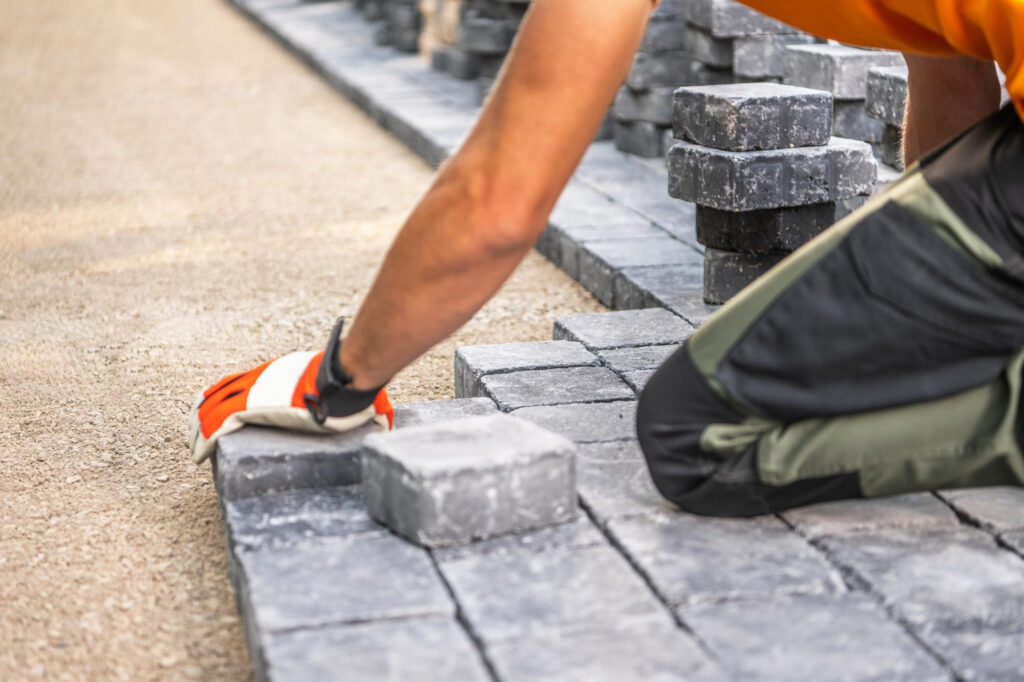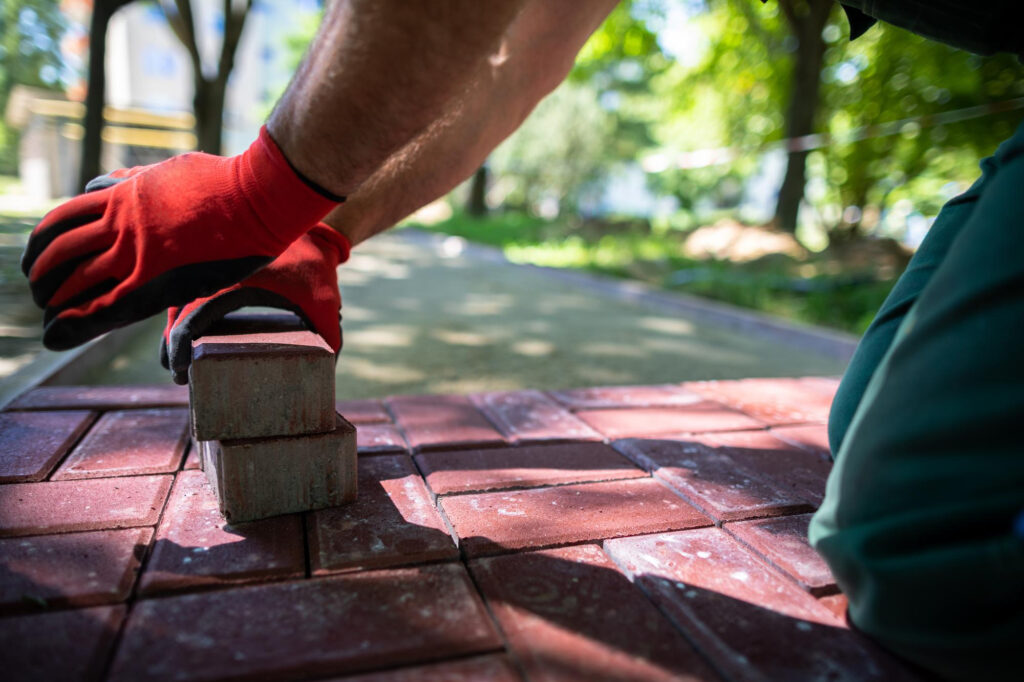Why Concrete Pavers Stand Out
Designed looks with stone-level character
Modern concrete pavers convincingly emulate the textures and color variations of natural stone. You’ll find tumbled edges for a time-worn look, crisp profiles for contemporary spaces, and multi-tone blends that add depth and hide dust. Borders, bands, and inlays create a tailored finish that frames driveways and patios like trim on a well-made suit. Because pavers are modular, you control the pattern and scale—from large-format rectangles to mixed-size ashlar sets—so the surface feels intentional rather than generic.
Style ideas
- Driveways: 45° herringbone for maximum interlock, with a contrasting soldier-course border.
- Patios: Ashlar (mixed sizes) for an organic, high-end feel.
- Walkways: Running bond to elongate narrow paths; add low path lighting for safety.
- Courtyards: Large-format units with tight joints for a minimalist, gallery look.
Built for everyday life
A well-built paver system handles kids, pets, furniture, and frequent entertaining with ease. Routine rinsing and a simple periodic clean are usually enough. A penetrating sealer adds extra protection against BBQ grease, leaf tannins, and UV exposure and makes cleanup faster after big weekends. Unlike large concrete slabs, which can crack and require visible patches, pavers maintain their appearance over time with straightforward care.
Smarter drainage options
Where puddling or run-off is a concern, permeable pavers shine. Their joint structure and engineered base allow water to pass through the surface and infiltrate or temporarily store below, reducing standing water and easing the load on surface drains. Around pools, long driveways, or tight urban lots, this can make a noticeable difference in comfort and performance.
Easy, targeted repairs
If a unit chips or a small area settles, pavers make repairs simple. Lift the affected units, adjust the bedding layer, and reset—no demolition of a whole slab or visible color mismatch. Ordering a few extra pieces with your original install ensures a perfect match for future touch-ups and keeps long-term ownership costs low.
Safer underfoot
Many residential pavers feature micro-texture for traction. Joint lines also break up surface water film, which helps on slopes and in wet seasons. Around pools, lighter color blends feel cooler to bare feet than darker, heat-absorbing surfaces, and tumbled textures provide a comfortable grip without feeling abrasive.
Real value over time
Installed costs typically sit higher than basic broom-finish concrete and lower than many natural stones. Over the long run, pavers often come out ahead thanks to fewer crack-related issues, quick repairs, and enduring curb appeal that supports resale value.

What a Proper Paver Install Includes
A long-lasting surface starts below the surface. Planning and base work matter most.
- Plan & set heights
We check slope, water flow, door thresholds, steps, turf, and planting so finished heights are correct. - Excavate & compact
We remove soil to the right depth, fix soft spots, and compact base rock in layers. This stops future movement. - Geotextile (if needed)
A fabric layer can keep soil from mixing into the base. This helps strength and drainage. - Build base & bedding
We install Class II base rock to spec, then screed a flat bedding layer so pavers sit even and tight. - Edge restraints
Concrete or engineered edging keeps the field from spreading and keeps borders straight. - Lay pattern & make cuts
We keep joints even, lines straight, and cuts clean. Borders and inlays line up with your home’s features. - Joint sand & lock-in
Polymeric sand goes into the joints, then is set so it resists wash-out and helps block weeds. - Seal (optional)
Sealer deepens color, adds stain resistance, and makes cleaning easier—useful in high-traffic or leafy areas.
Choosing Your Paver: A Simple Framework
- Look: Tumbled for classic charm; rectified edges for modern lines; cobble textures for European character.
- Size: Mixed-size sets soften large areas; large-format slabs create a sleek, minimal aesthetic.
- Pattern: Herringbone for driveways, ashlar for patios, running bond for narrow paths or side yards.
- Color: Lighter blends feel cooler and show less dust; variegated blends hide leaves and everyday scuffs.
Where Pavers Work Best Around the Home
- Driveways: Vehicle-rated pavers, reinforced edges, and interlocking patterns resist racking and rutting.
- Patios & outdoor kitchens: Mixed patterns, accent borders, seating walls, and lighting build true outdoor rooms.
- Pool decks & coping: Comfortable textures, cooler colorways, and drain-friendly bases create safer, more usable spaces.
- Walkways & entries: Clean lines, subtle borders, and step treads guide movement and improve safety.
- Fire pit courts & seating nooks: Heat-tolerant surfaces with easy clean-up after gatherings.
- Steps, borders & inlays: Contrasting color or texture adds visual interest and helps define zones.

Care & Maintenance :
- Weekly/Monthly: Sweep or rinse to remove debris; spot-clean spills promptly.
- Seasonal: Low-pressure wash; inspect for joint sand loss and top up as needed.
- Periodic: Reseal high-traffic areas to maintain color depth and stain resistance.
- Repairs: If a piece chips or an area settles, lift → adjust bedding → reset → re-sand. It’s quick and blends seamlessly.
FAQs
Are concrete pavers strong enough for driveways?
Yes—when you use driveway-rated pavers, a properly compacted base, and interlocking patterns (like herringbone). This combination distributes vehicle loads effectively and resists deformation over time.
Will pavers shift or grow weeds?
Shifting is usually a base-prep issue. With correct excavation, compaction, and edge restraints, movement is rare. Weeds sprout from airborne seeds landing in joints; polymeric sand and routine sweeping make them far less likely.
Do pavers fade or stain?
All exterior materials weather. A penetrating sealer slows color fade, adds stain resistance, and makes cleaning easier. Blended colors also disguise minor wear better than flat tones.
Are pavers slippery when wet?
Most residential pavers include textured faces that improve grip. Around pools and on slopes, we specify higher-friction profiles and patterns that shed water efficiently.
How do pavers compare with poured concrete on cost?
Basic broom-finish concrete is often cheaper upfront, but slab cracks are common and patches are highly visible. Pavers usually cost less than many natural stones and save money over time because repairs are targeted and appearance stays consistent.
What’s the benefit of permeable pavers?
They help manage stormwater by allowing water to pass through joints into a designed base. That reduces puddling, supports healthier adjacent landscaping, and can ease pressure on surface drains.
How long do pavers last?
Decades with proper base construction, joint stabilization, and routine care. Modular hardscapes have been proven on streets and plazas worldwide—your patio or driveway benefits from that same system strength.
Why Homeowners Choose Us:
- Design guidance: Sizes, patterns, borders, and colorways chosen to complement your home—not fight it.
- Right build, right base: Proper excavation, compaction, and drainage from the start.
- Detail-obsessed finishes: True lines, tight cuts, clean jointing, and crisp borders.
- One team, end to end: Consultation, materials, installation, and aftercare—all coordinated for a smooth experience.
Ready to Plan Your Project?
Whether you’re upgrading a family patio, building a vehicle-rated driveway, or creating a comfortable pool deck, we’ll help you choose the right paver style, pattern, and base—and install it the right way.
GLscapes — Residential Pavers & Outdoor Living
Call/Text: (415) 419-1937 • Licensed & Insured
Ask about design options, permeable systems, and integrated lighting/planting for a complete outdoor transformation.
